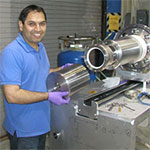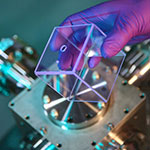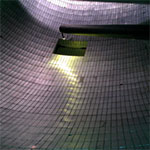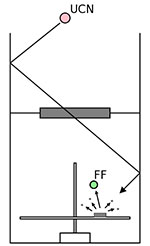UCN Experiments
UCNA
 The UCNA experiment is the first experiment to utilize UCN for angular correlations measurements in beta-decay.
The UCNA experiment is the first experiment to utilize UCN for angular correlations measurements in beta-decay.
UCNA was founded in 1997-1998 as a part of the already ongoing UCN program at Los Alamos, and provided the motivation for development of the production source in Area B at LANSCE.
Angular correlation measurements in neutron beta-decay contribute, together with the neutron lifetime and radiative decay experiments, to a high precision determination of the parameters of the charged weak current of the nucleon. Neutron decay serves as the definitive source for some of these parameters, in particular the axial coupling constant of the nucleon, important for high precision calculations of the solar fusion rate, high precision measurements of neutrino flux and for constraints on various extensions of the standard model of particle physics.
UCNA measures the beta-asymmetry, or the correlation between the neutron spin and the decay beta-particle. UCNA exploits the properties of UCN to produce a decay geometry which is competitive with more conventional cold neutron beam experiments. In particular, when coupled to the unique detector geometry for the UCNA experiment, the stored UCN produce extremely low neutron-generated backgrounds in the beta-decay detectors.
UCNA was ranked as the second highest priority of the fundamental neutron science program in the Nuclear Science Advisory Committee comprehensive review of fundamental neutron science in 2011, and published an update of the beta-asymmetry with sub-1% precision in 2013.
Point of Contact: Andy Saunders
UCNB
 The UCNB experiment improves upon the spectrometer used for UCNA to investigate more correlations in neutron decay. In UCNB, the protons that are also emitted in the decay of the neutron are detected in coincidence with the decay electrons. A measurement of the electron and proton direction of emission relative to the direction of the neutron spin permits access to additional angular correlation parameters, including the proton asymmetry and the neutrino asymmetry.
The UCNB experiment improves upon the spectrometer used for UCNA to investigate more correlations in neutron decay. In UCNB, the protons that are also emitted in the decay of the neutron are detected in coincidence with the decay electrons. A measurement of the electron and proton direction of emission relative to the direction of the neutron spin permits access to additional angular correlation parameters, including the proton asymmetry and the neutrino asymmetry.
Recent theoretical work at LANL has provided renewed interest in the measurement of these additional parameters: these parameters are sensitive to the presence of new physics beyond the Standard Model at energy scales rivaling those probed in high-energy collisions at the Large Hadron Collider.
A significant amount of new technology has been developed for the experiment such as novel, thin, pixellated silicon detectors that provide a precision measurement of the decay electron's energy. These detectors have been implemented in the UCNA magnetic spectrometer along with a 30,000 Volt accelerating electric potential that accelerates the low-energy protons for detection.
Point of Contact: Mark Makela
UCNb
 The UCNb experiment is designed to be a compact, beta calorimeter and ultracold neutron storage cell, combined into one small apparatus.
The UCNb experiment is designed to be a compact, beta calorimeter and ultracold neutron storage cell, combined into one small apparatus.
The experiment is located as close as possible to the bright LANSCE UCN source to achieve a density of neutrons inside the cell. UCNb is tasked with measuring the spectral shape parameter, b, the so-called Fierz interference term, of neutron beta decay in order to test for decay channels not predicted by the Standard Model.
Nab
The Nab experiment will detect protons and electrons in coincidence from the decay of unpolarized cold neutrons at the SNS facility at Oak Ridge National Lab.
The specialized silicon particle detectors for the Nab experiment are being designed and assembled at LANL and tested using the neutrons and superconducting magnets at the LANSCE UCN facility.
Point of Contact: Mark Makela
UCNτ
 The half-life (or lifetime τ) of the neutron is intimately connected to many other processes in particle physics and cosmology, such as the abundance of nuclei in the early universe, neutrino physics, and when combined with neutron decay correlations, tests for new particle physics phenomena. In spite of a 60 year history of measurements, recent experimental determinations of the half-life do not agree, and new techniques and technology are being developed at LANSCE make an improved measurement.
The half-life (or lifetime τ) of the neutron is intimately connected to many other processes in particle physics and cosmology, such as the abundance of nuclei in the early universe, neutrino physics, and when combined with neutron decay correlations, tests for new particle physics phenomena. In spite of a 60 year history of measurements, recent experimental determinations of the half-life do not agree, and new techniques and technology are being developed at LANSCE make an improved measurement.
The experiment is designed to trap UCNs with minimal sources of loss aside from beta decay: in this way, UCNs are introduced into the trap, and the number of surviving neutrons is measured to deduce the half-life. In past “UCN bottle” experiments, material traps are used to confine the UCNs which, in addition to decaying, can be absorbed or scattered by the material walls, and these material interactions must be understood carefully to determine the neutron half-life.
In contrast, UCNτ uses a magnetic trap to confine the neutrons so that they do not interact with material surfaces while being stored. A 670 liter magnetic trap composed of over five thousand NdFeB magnets (the largest of its kind) was successfully commissioned in early 2013, and research and development of new UCNs detection methods are underway to further improve upon previous measurements.
Point of Contact: Andy Saunders
UCNS
 While UCNs are of great interest to fundamental physicists, their properties make them uniquely suited to perform detailed studies of other materials. A new program at the LANSCE UCN source uses UCNs to finely control fission in actinides such as plutonium and uranium in order to investigate sputtering and damage of material surfaces, topics which are essential to the NNSA’s mission. The mechanism behind material damage due to sputtering from fission is not well understood and represents one of the modern challenges facing nuclear scientists.
While UCNs are of great interest to fundamental physicists, their properties make them uniquely suited to perform detailed studies of other materials. A new program at the LANSCE UCN source uses UCNs to finely control fission in actinides such as plutonium and uranium in order to investigate sputtering and damage of material surfaces, topics which are essential to the NNSA’s mission. The mechanism behind material damage due to sputtering from fission is not well understood and represents one of the modern challenges facing nuclear scientists.
The novel technique of using UCNs will provide a new avenue for studying the particle dynamics of material sputtering due to fission. The UCNs cross-section for fission is several hundred times higher than that of thermal neutrons, and the UCNs energy finely tuned via gravitational acceleration or deceleration. Their penetration depth can be adjusted to as low as a few microns, allowing very sensitive studies of the effect of material thickness, or the properties of oxide layers on the surface. From the morphology and distribution of sputtered atoms ejected from the material, we will insight into the underlying process and resolve questions about competing theoretical models.
This work is supported by the G. T. Seaborg Institute for Transactinium Science and the U.S. Department of Energy through the LANL/LDRD Program.
Point of Contact: Mark Makela
LANL Electric Dipole Moment (LANL nEDM)
A new effort is under way at LANL, taking advantage of the unique LANSCE UCN source, to develop a room temperature nEDM experiment with a sensitivity of δdn~3x10-27 e-cm, a 10 fold improvement over the current limit set by an experiment at ILL.
The work includes an upgrade of the UCN source and prototyping of a new nEDM experiment apparatus. The short term goal (FY14-FY16) is to demonstrate storage of the number of UCNs sufficient for a δdn~3x10-27 e-cm e-cm experiment in a realistic nEDM prototype apparatus.
This work is supported by the LANL/LDRD program.
Point of Contact: Takeyasu Ito
SNS nEDM
An electric dipole moment (EDM) measures the separation of positive and negative charges within a system and is an extremely sensitive probe of physics beyond the standard model. A new neutron EDM (nEDM) experiment is being developed to be installed at the Fundamental Neutron Physics Beamline (FnPB) at the Spallation Neutron Source (SNS) at Oak Ridge National Laboratory, with a goal sensitivity of δdn~5 x10-28 e-cm, an improvement of two orders of magnitude over the current limit set by an experiment at ILL.
Based on a method proposed by Golub and Lamoreaux, this experiment will be performed in a bath of superfluid liquid helium at 0.4 K. LANL is leading several important R&D efforts. One of them is development and testing of UCN storage cells. UCNs from LANSCE have been used to test prototype UCN storage cells.
Point of Contact: Takeyasu Ito

